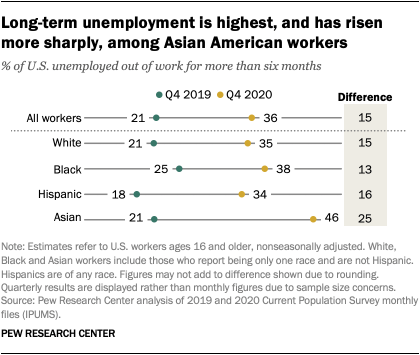The economic downturn caused by the coronavirus pandemic continues to take a toll among American workers. Asian Americans are getting hit hard as more of them stay jobless for longer periods of time.
Data released Thursday by the Pew Research Center shows another crack in the model minority myth that distorts the image most Americans have of Asian Americans.
As the U.S. economy copes with the effects of the coronavirus outbreak, a rapidly rising share of unemployed Americans find themselves out of a job despite many months of searching.
Even amid signs of improvement in the U.S. labor market overall, about four-in-ten unemployed workers had been out of work for more than six months in February 2021, about double the share in February 2020. At the same time, a growing number of job seekers are becoming discouraged, leaving the labor force entirely, according to a new Pew Research Center analysis of government data.
The number of Americans who are out of work and have experienced long-term unemployment – that is, those who have been looking for a job for more than six months – has increased considerably in the year since the start of the COVID-19 recession.
The number of Americans who are out of work and have experienced long-term unemployment – that is, those who have been looking for a job for more than six months – has increased considerably in the year since the start of the COVID-19 recession.
By February 2021, 4.1 million Americans were among the long-term unemployed, without work since at least August, making up 2.6% of the workforce overall. The sharp rise in long-term unemployment in the current recession stands in stark contrast to the Great Recession of 2007-09, when it took nearly two years for the long-term unemployment rate to reach similar heights. Job losses during the coronavirus recession have affected some demographic groups more than others, and the rise in long-term unemployment has been greater among Asian American unemployed workers, especially men.
Likewise, the ranks of discouraged workers – unemployed workers who are currently not looking for work because they believe no jobs are available for them or there are none for which they qualify – have swelled in recent months. About 529,000 Americans were classified as discouraged workers in February 2021, roughly 100,000 more than the number one year ago.
Long-term unemployment rose more sharply among Asian American workers who are unemployed. In the fourth quarter of 2020, nearly half of unemployed Asian workers (46%) had been out of work for more than six months, compared with 21% in the fourth quarter of 2019. Black unemployed workers had the next highest long-term unemployment rate (38%) at the end of 2020, followed by White (35%) and Hispanic (34%) unemployed workers. For these three groups of unemployed workers, the long-term unemployment rate was around 15 percentage points higher than one year earlier.
Likewise, the ranks of discouraged workers – unemployed workers who are currently not looking for work because they believe no jobs are available for them or there are none for which they qualify – have swelled in recent months. About 529,000 Americans were classified as discouraged workers in February 2021, roughly 100,000 more than the number one year ago.
Long-term unemployment rose more sharply among Asian American workers who are unemployed. In the fourth quarter of 2020, nearly half of unemployed Asian workers (46%) had been out of work for more than six months, compared with 21% in the fourth quarter of 2019. Black unemployed workers had the next highest long-term unemployment rate (38%) at the end of 2020, followed by White (35%) and Hispanic (34%) unemployed workers. For these three groups of unemployed workers, the long-term unemployment rate was around 15 percentage points higher than one year earlier.

These patterns differ from the percent of all workers who are unemployed regardless of duration. Black workers (9.8%) had the highest unemployment rate overall in the fourth quarter of 2020, followed by Hispanic (8.7%), Asian (6.3%) and White workers (5.1%).
The reason for the relatively high long-term unemployment rate among Asian unemployed workers is not entirely clear. But it may be partially explained by the fact that they tend to be disproportionately represented in states most impacted by coronavirus shutdowns.
Nearly a third of Asian Americans (31%) lived in California in 2019, a state that had some of the longest shutdowns and most severe outbreaks in 2020.
New York is the state with the second largest share of the Asian population (9%) and suffered the third most employment losses since the start of the pandemic.

No comments:
Post a Comment